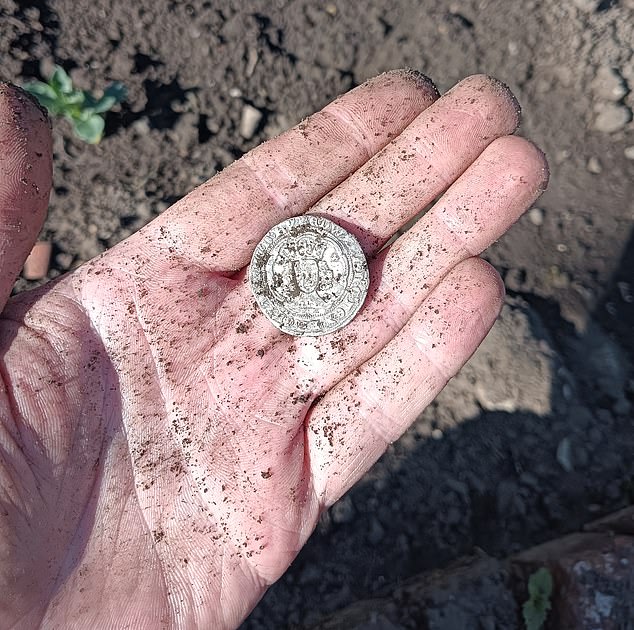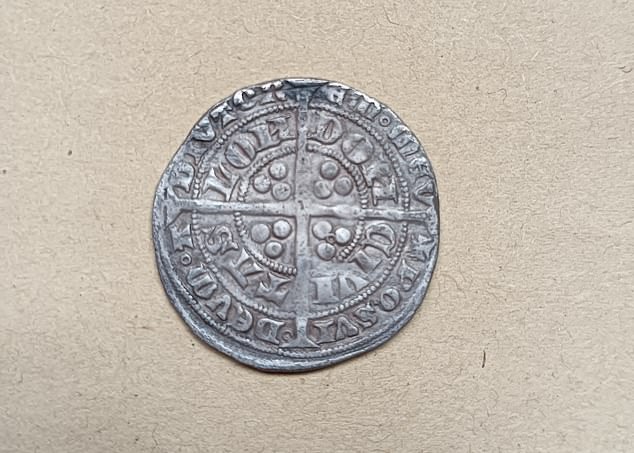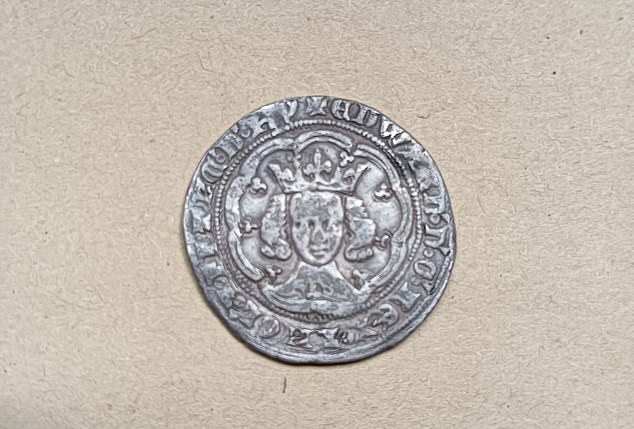I dug up a 650 year old silver coin in my garden and it taught me something about cash today
Encountering hidden treasures has a timeless appeal, from Robert Louis Stephenson’s classic 1883 novel Treasure Island to the TV show The Detectorists.
I recently found a hidden treasure myself, in the form of an old silver coin.
The most valuable thing about it turned out to be its history, rather than its being worth vast amounts of money.
But I think the story of this one coin teaches us modern lessons about the value of money, and how the way we make and spend coins has changed little in 650 years.
It even tells us something about the ever-present nature of fraud.
The coin had been hidden in a flower bed for hundreds of years… until I accidentally dug it up
Recently I was in my garden digging up some weeds that were threatening to overgrow my vegetable garden when I noticed something glistening in some fallen earth.
I thought it was an old bottle cap and went to pick it up, only to discover it was a silver coin. As I swept away the ground, I was intrigued to discover that the coin looked ancient and was covered in Latin script and the image of a king I did not recognize.
I took my find inside and decided to learn as much as I could about the coin – with my immediate thought being that it could be valuable, and that I might find even more hidden in the earth.
So I spoke to some coin experts to find out more about the history of this mysterious coin, with, I think, some fascinating results.
A numismatic expert at Hattons in London – the technical term for someone who studies money and coins – told me the coin is a silver backbone, made during the reign of King Edward III between 1356 and 1361 and made of 92.5 percent pure silver .
However, my daydreams of selling the coin and taking early retirement were about to be dashed as Hattons subsequently valued the coin at around £100 to £150, while auctioneers Warwick & Warwick put it at £50 to £ 80 rated.
Barely enough to call yourself rich by the standards of 1361, let alone 2024.
The groat was worth 4 pence in the 14th century, which was about two days’ wages for a basic worker, or one day’s wages for a skilled worker such as a carpenter.
In the Middle Ages, the coin would have bought two chickens, sixteen pints of beer, two pounds of cheese or two dozen eggs.
Unfortunately, my Latin is a bit rusty and I was unable to decipher the fragmented text printed on the coin, apart from the words ‘London’ and ‘Edward’.
Fortunately, Hattons was able to do that.

Even covered in dirt, it was clear that this silver coin was worth further investigation
The reverse of the coin reads ‘Edward DG Rex ANGL & Franc D Hyb’ – or ‘Edward, by the grace of God, King of England and France, Lord of Ireland’.
On the other hand, the Latin ‘Posui Deum A Diutor Em Meu’ translates as ‘I have made God my helper’, and the text ‘Civi Tas London’ means, as you can probably guess, that the coin is in London beaten – in the Tower of London, to be precise.
In a sense, very little has changed when it comes to the monarch’s impact on our money today.
Not only do coins still bear the likeness of the ruling king or queen, but many coins still bear text implying they have a divine right to rule, despite our increasingly secular culture.
Take, for example, the inscription on today’s £1 coins: ‘Charles III Dei Gra Rex Fid Def’, or ‘King Charles III, reigning by the grace of God, defender of the faith’.
The coin itself also features an interesting early anti-fraud feature.

The large cross is intended to make it easier to see if silver has been removed from the coin
The ‘tail’ side of the coin has a large cross, running from edge to edge. The purpose of this cross is to reveal if someone has removed metal from the edge, also known as ‘clipping’.
If a criminal were to clip enough coins, they could essentially make free money by melting down the silver filings and making new fake money, or else making bullion silver to resell.
So in 1247, mints began making coins with the so-called ‘long cross’ design, which made clipped coins easier to recognize.
This was important in the Middle Ages because the value of a coin was based on the value of the precious metal it contained, and public confidence in that idea was the basis of the entire idea of coinage.
“This was an era when the money in your pocket was only worth as much as the precious metal it contained,” Hattons said.

The coin features the likeness of King Edward III and was minted in the middle of his life
Merchants had a dim view of clipped coins being essentially less valuable than intact coins, and coin clippers could face the death penalty if caught.
The silver dust I unearthed appears to have escaped the coin cutter’s scissors and is intact and in quite good condition – despite the best efforts of the 14th century fraudsters.
Again, not much has changed about physical money these days when it comes to fighting fraud. We are still building anti-crime measures into every coin and banknote, but our methods have only improved.
I’m not sure what a medieval coinmaker would have made of holographic banknotes, but they would have recognized that we shared the same goal: making currency more difficult to counterfeit.
Can you find your own medieval coin?
If you own a metal detector, you have a decent chance of finding such a coin yourself.
Richard Beale, appraiser in the collectibles department at auction house Warwick & Warwick, said: ‘Many coins from this period and earlier are being discovered by detectorists. There has been a lot of publicity about the discovery of valuable coins and this has encouraged landowners to allow detectorists on their land.’
But if you’re lucky enough to unearth a treasure, you can’t simply rely on the “finders keepers” principle.
Buried coins can have important cultural and financial value, so you may need to register everything you find.
If you find any treasure, you must report it to your local coroner within 14 days. The coroner will appraise it and try to sell it to a museum.
If you own the land where the item was found, you get its full value, and if you find it elsewhere, you get up to 50 percent. You need permission from the landowners. You may have to pay capital gains tax.
Treasure is any metal object that is at least 300 years old and contains no less than 10 percent precious metal.
If that item is a coin, you must have found at least two to count as treasure. However, if you find coins with less than 10 percent precious metal, they don’t count as treasure unless you find 10 or more.
Prehistoric metal objects are always treasures, and if you find two prehistoric objects in the same place, they are treasures even if they are not made of metal.
If you find precious metal objects that are less than 300 years old, report them if they were deliberately hidden.
From July 30, any object can be considered a treasure if it is made of any metal, is at least 200 years old and is of historical importance.
Sadly, I never discovered any more silver grits hidden among the weeds in my garden, and I would clearly have to find quite a few of them to die a rich man.
But this one coin has still proven to be priceless and has taught me more about the history of money, how little has changed – and, unfortunately, the never-ending attempts of ne’er-do-wells to separate us from that money .
Kings and queens come and go, but fraudsters seem to be here to stay.
Some links in this article may be affiliate links. If you click on it, we may earn a small commission. That helps us fund This Is Money and keep it free to use. We do not write articles to promote products. We do not allow a commercial relationship to compromise our editorial independence.
